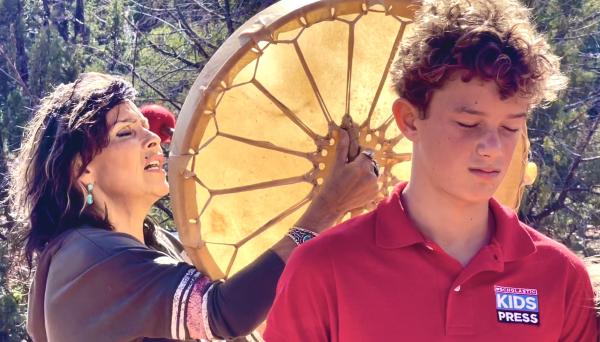KID REPORTERS’ NOTEBOOK
Sedona’s Native American Heritage
The Southwestern United States is home to many Native American tribes and heritage sites. To learn more about their culture and history, I recently traveled to Arizona.
The United States Forest Service preserves the Honanki Heritage Site. It is located in the Coconino National Forest, about 15 miles west of Sedona. The ancient cliff dwellings and rock art were created by the Sinagua people before written records. These early Americans are ancestors of the modern Hopi, one of the 22 tribes federally recognized in Arizona.
Pictographs (painted images) and petroglyphs (images carved out of rock) created by the Sinagua document farming, tribal conflicts, and even natural disasters. “The Sinagua came here between 900 and 1100 A.D.,” said local guide Phillip LeBlanc. “The pictographs tell us more about how they lived.”
The Sinagua lived in rooms carved from the cliffs. They hunted for food, raised crops, and made tools from stone, leather, and wood. Most significant to LeBlanc is a pair of handprints left behind. “Those prints are rare in the American Southwest,” he said. “They indicate that the community has left the site they worked to create. Why is it important? You’re always going to know where you came from.”
A volcanic eruption of Sunset Crater may have led to the deparature of the Sinagua Pueblo Indians sometime between 1064 and 1067 A.D.
A CASTLE IN A CLIFF
Reachable only by ladder, Montezuma Castle National Monument is embedded in limestone 90 feet above ground level.
“90% of the castle is in its original state,” said Lori Racay Fick, a volunteer for the National Park Service. “It sits under the limestone overhang, so much of the castle never gets wet.
This cultural landmark provides more information about the Sinagua. “The Hopi tribes of today believe the Sinagua to be their ancestors,” Fick said. “They still come here to do offerings and prayers.”

Elizabeth Silk, a Hopi Medicine Woman, performs a healing ceremony with Quade at the Medicine Wheel in Sedona.
MODERN MEDICINE WOMAN
Ceremonies and ties to the land are cornerstones of Native American culture. During my visit, I spoke with Elizabeth Silk, a Medicine Woman of Chippewa and Sioux descent. Silk took me to a site in Sedona known as the Medicine Wheel to share the importance of respecting and preserving this cultural heritage.
“We begin with a spoken prayer from the Lakota Sioux Nation,” Silk said. “‘Aho Mitakuye Oyasin,’ which means ‘Thank you to all of my relatives.’”
Silk sang a Cherokee song while beating a drum. At the Medicine Wheel, it represents the Earth’s heartbeat. “Let go of any worries, fear, judgment, self-doubt,” she said. “Be kind, be loving, be considerate. I believe that love is the most powerful medicine there is.”
When asked about the Sedona landscape, Silk said, “This is a healing mecca, I do believe. But I also believe that every area in this world is a healing place. Wherever the love is, that’s where the healing is. Just bring the love, and you can create your own Sedona wherever you are.”
“This is a healing mecca,” Silk told Quade about Sedona.
